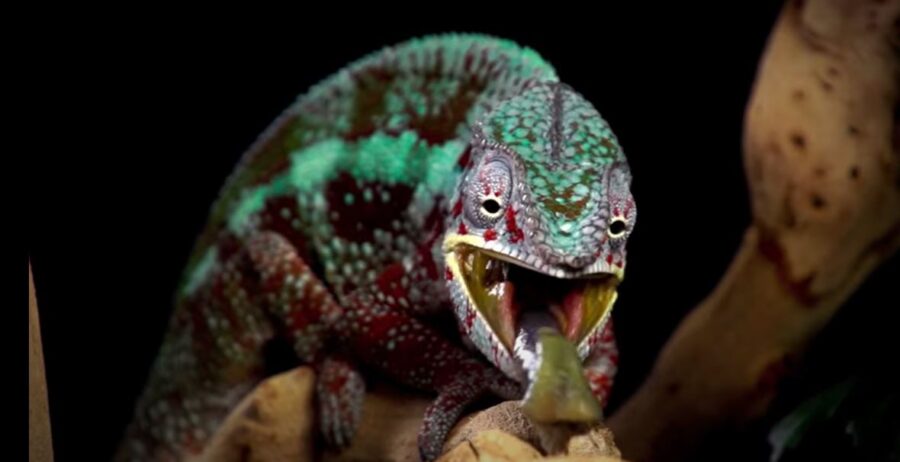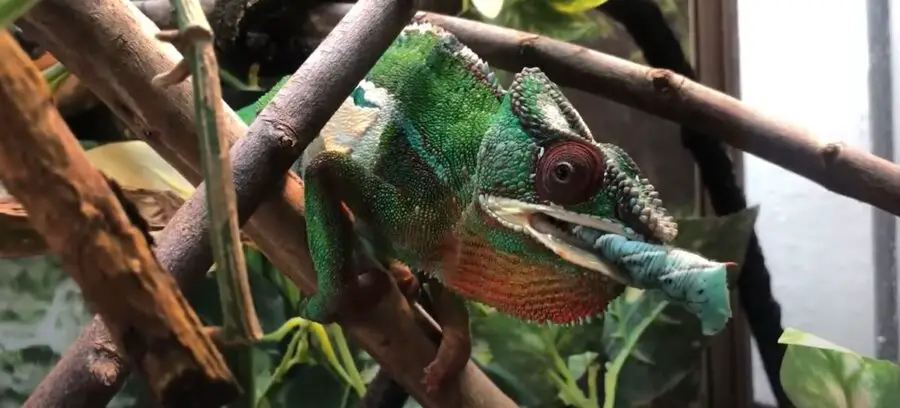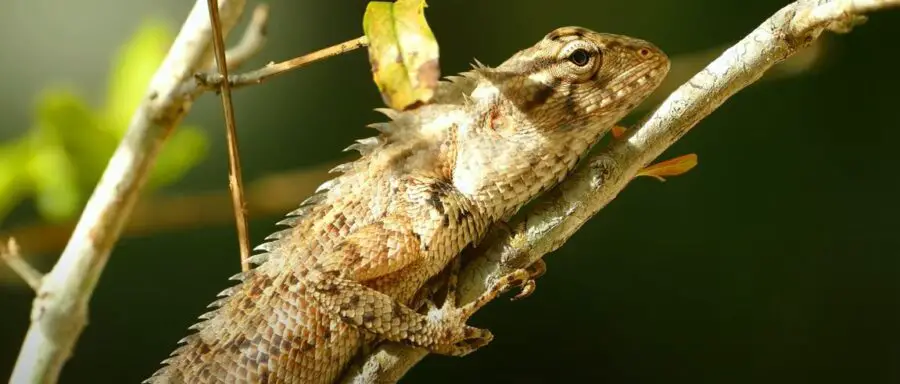What to feed a chameleon depends on their age, species and individual tastes. Can chameleons eat mealworms?
How can mealworms help or hurt chameleons? Is there a special way of offering them to your chameleons and how much is too much?
In this article we will discuss mealworms, dietary needs of chameleons and explain what this type of worm really is.
Can Chameleons Eat Mealworms?
Mealworms and many other insects can be included in the staple diet of a chameleon. They can also be gut loaded with fruits and vegetables to create a packed punch of nutrition for you chameleons to consume in one or multiple bites.
Make sure to add some dark leafy greens, crickets and occasional fruits as a treat for chameleons who live mainly off catching insects with their snapping tongue in the wild when their prey least expects it.
Mealworms are an easy meal, while crickets provides more of a challenge with the thrill of the hunt. Both can be sprinkled with calcium and multivitamins for additional nutrition.

What Are Mealworms?
The yellow mealworm beetle reproduces and leaves us with mealworms which are their larvae. The larval form is a rich food source for many reptiles including chameleons.
The stage prior is when they are just eggs and their larval stage is followed by the period in which they are categorized as pupa.
- Larvae or mealworms usually measure out to .09 inches in length or 2.5 centimeters.
- Adult yellow mealworms beetles grow to about 1.25 to 1.8 centimeters in length which equals about
0.49 to 0.71 inches.
Mealworms are safe for human consumption and a delicacy in Some Asian countries. Birds also enjoy eating them along with many reptile species.
Mealworms eat vegetation and will gladly accept any leftover vegetables you have available. You can gut load mealworms prior to serving them to your chameleons or other reptile companions.
Are Mealworms Safe for My Veiled Chameleon?
Yes. Your veiled chameleon is one of the most popular types of chameleons in captivity. They require protein from insects and worms alike.
Feeding them mealworms is considered safe and recommended unlike hornworms that should be offered sparingly because of their lower protein content. More information on hornworms is available here.
Here are some others options for your veiled chameleon to consume in their enclosure:
- Roaches
- Crickets
- Beetles
- Superworms
- Butterworms
- Waxworms
- Silkworms
- Tomato hornworms
Some are more challenging to eat than others. This is because they are more nimble when placed inside the cage where your veiled companion goes on a mission to hunt them down.
Some veiled chameleons may lose interest in captive care and would prefer a mealworm gut loaded with nutrients by way of vegetables before being fed to your reptile compassion.
Can I Give My Chameleon Dried Mealworms?
It is not a problem to give dried mealworms to your chameleon, but this is not an ideal method of delivery. The purpose of the enclosure and captive care is to recreate or mimic conditions in the wild.
We are not only caring for chameleons, but also managing the ecosystem they live inside. In order to recreate this image of a wild habitat, the foods we feed our chameleons should be given live or fresh.
A dried mealworm also contains less protein and may also lose its nutrient density as well. Mealworms that are alive and fresh also contain moisture that your chameleon can absorb to remain hydrated when they do not drink as much water as we wish for them to consume.
I only feed dried mealworms when I run out of live insects and I can’t go to the pet shop for a while. The dried mealworms are my backup plan and used in case of emergency, urgency or when live insects run out.

How Many Mealworms Can I Give To My Chameleon?
Mealworms are packed with protein, but you can make them more nutrient dense by gut loading them first. When mealworms consume veggies, they will bulk up in nutrition.
Then, you do not need to give too many to your chameleon at once. 3-4 mealworms who are average in size are enough for a single feeding to an individual chameleon. Any more than that is excessive and can create gut issues or leftovers.
I have noticed that overconsumption of protein for my chameleon results in impaction. He strains more when he has to poop after eating more than 4 mealworms in one day.
Can Chameleons eat Waxworms?
Yes. Waxworms are included in the list of protein packed staple foods to feed a chameleon. This insectivore reptile that you care for as your companion would benefit from eating:
- waxworms
- crickets
- silkworms
- calcium worms
- earthworms
- buffalo worms
- morios
- butter worms
- mealworms
- bamboo worms
Some worms or insects are already gut loaded when you buy them alive. You can feed them prior to giving them to your chameleon.
You can also sprinkle supplements like calcium or multivitamins once a week or every 2 weeks for extra vitamins and minerals to fortify your chameleon’s diet.
Can Baby Chameleons Eat Mealworms?
Younger chameleons, whether they are babies or juveniles, can be fed mealworms in their regular diet. They will eat and shed more often. This requires more vitamins and minerals during their growth stages and development.
Feed your baby or juvenile chameleons twice a day. The mealworms should be smaller in size. You can also look for crickets that are ⅜ of an inch.
Crickets are a more common meal for chameleons who would like to catch their prey rather than consuming a mealworm in a dish. Adding finely chopped dark leafy greens to a baby or juvenile chameleon’s diet is also recommended.
If you notice that there are leftovers when the second feeding of the day comes, remove the stale or remaining food before replacing it with a new supply.

Can Chameleons Eat Fruit?
Chameleons are mainly insectivores, but you can categorize them as omnivores as well. This is because they will appreciate vegetables and fruits as well.
Some chameleons love fruit like veiled chameleons and others do not, such as the panther chameleon. It’s best to check on the species of chameleon you are caring for when offering fruits.
Higher calcium fruits with lower phosphorus ratio is recommended such as:
- Apples
- Peaches
- Blueberries
- Prickly pear cactus
- Mango
- Melons
- Bananas
- Cantaloupe
Feeding fruits more than once a week is not necessary and portions should remain smaller than a handful or about half a cup in size.
Can Chameleons Eat Grasshoppers?
Yes. Since chameleons are insectivores and opportunistic predators in the wild. They do not discriminate between many types of prey that are available near them.
A grasshopper is routinely a victim from the tongue snap that a chameleon can display when they sneak up and take down their next meal.
Grasshoppers are among many insects that stand no chance against chameleons. Flies, crickets and many types of worms are consumed by chameleons in the wild and in captivity.

Health Benefits Of Mealworms
Mealworms are a healthy source of food for your chameleons and many other animals. They are rich in:
- Omega-3 fatty acids
- B vitamins (including vitamins B5 and B12)
- Proteins
- Fiber
Omega-3 fatty acids
Bone and joint health for a chameleon is crucial for their mobility. Otherwise they will be lethargic or refuse to enjoy their enclosure. These fatty acids also help for healthy eyes and skin.
B vitamins
B vitamins will help your chameleon to absorb proteins and fats by breaking them down properly. Their energy production will increase as they are able to metabolize foods better.
B vitamins improve muscles, skin, hair, and eyes. B5 and B12 vitamins assist in the growth of juvenile chameleons as they develop into adults.
Proteins
The proteins in mealworms are packed to help repair and build muscles. It also promotes healthy skin and regulates their blood as well.
Fiber
The fiber in mealworms is enough to assist with gut movement to prevent impaction. We still recommend adding dark leafy greens as well to promote gut health and prevent constipation.
How To Feed Mealworms To Chameleons
Mealworms alone are not enough to cover the nutritional needs of your chameleon. There are tricks to this to add more nutrition by gut loading or sprinkling them with added vitamins and minerals.
Try to also feed your chameleon crickets and dark leafy greens as well in their weekly diet. Mealworms should always be procured from trusted retailers to make sure they are free of parasites, pathogens and pesticides.
Getting freeze dried mealworms loses its nutrition and makes me more skeptical of how they were raised. Your chameleons want them alive. You can coat them with multivitamins, calcium sprinkled on top and feed them vegetables before you give them to your chameleon.
Remove any uneaten mealworms for their enclosure if they remain there for half of a day or longer. Juveniles can consume as much as they can handle, but we stick to about 3-4 mealworms a day. Adult chameleons enjoy daily mealworms, crickets and leafy greens as a powerful trio for their dietary needs.
Thank you for visiting PocketPetCentral.com for the best information to help you enjoy the life of your pocket pet companion in a fun, safe & healthy way.


